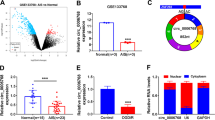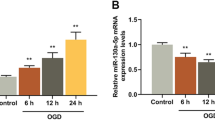Abstract
Histone deacetylase (HDAC) inhibitors can protect the brain from ischemic injury. This study aimed to identify the regulation of HDAC3 in cerebral ischemic injury. Middle cerebral artery occlusion (MCAO) was performed to establish a mouse model with cerebral ischemic injury, in which expression of HDAC3 and miR-19a was evaluated using RT-qPCR. In MCAO mice with silencing of HDAC3, infarct volume was determined using 2,3,5-triphenyl tetrazolium chloride (TTC) staining, and serum levels of TNF-α, IL-6, and IL-8 were measured using ELISA. An in vitro model was constructed in human umbilical vein endothelial cells (HUVECs) with oxygen-glucose deprivation/reoxygenation (OGD/R), followed by gain- and loss-of-function experiments. Relationships among miR-19a, HDAC3, and syndecan-1 (SDC1) were explored using RIP, ChIP, and dual-luciferase reporter assays. The expression of HDAC3, SDC1, JAK1, and STAT3 along with the extent of JAK1 and STAT3 phosphorylation was measured by Western blot analysis. HUVEC viability, apoptosis, and angiogenesis were assessed by CCK-8, flow cytometry, and angiogenesis assays in vitro separately. We found elevated HDAC3 and downregulated miR-19a expression in the MCAO mice. Decreased TNF-α, IL-6, and IL-8 serum levels were observed in response to silencing of HDAC3. HDAC3 inhibited the expression of miR-19a, which in turn targeted SDC1, leading to JAK1/STAT3 signaling pathway activation. HDAC3 overexpression or miR-19a inhibition repressed HUVEC viability and angiogenesis but enhanced HUVEC apoptosis. Our data unraveled the mechanism whereby HDAC3 inhibition ameliorated cerebral ischemic injury by activating the JAK1/STAT3 signaling pathway through miR-19a-mediated SDC1 inhibition.








Similar content being viewed by others
Data Availability
The datasets generated/analyzed during the current study are available.
References
Mozaffarian D, Benjamin EJ, Go AS, Arnett DK, Blaha MJ, Cushman M, de Ferranti S, Despres JP et al (2015) Heart disease and stroke statistics--2015 update: a report from the American Heart Association. Circulation 131(4):e29–e322
Iadecola C, Anrather J (2011) The immunology of stroke: from mechanisms to translation. Nat Med 17(7):796–808
Radenovic L, Nenadic M, Ulamek-Koziol M, Januszewski S, Czuczwar SJ, Andjus PR, Pluta R (2020) Heterogeneity in brain distribution of activated microglia and astrocytes in a rat ischemic model of Alzheimer's disease after 2 years of survival. Aging (Albany NY) 12(12):12251–12267
Radak D, Katsiki N, Resanovic I, Jovanovic A, Sudar-Milovanovic E, Zafirovic S, Mousad SA, Isenovic ER (2017) Apoptosis and Acute Brain Ischemia in Ischemic Stroke. Curr Vasc Pharmacol 15(2):115–122
An P, Xie J, Qiu S, Liu Y, Wang J, Xiu X, Li L, Tang M (2019) Hispidulin exhibits neuroprotective activities against cerebral ischemia reperfusion injury through suppressing NLRP3-mediated pyroptosis. Life Sci 232:116599
Pluta R, Ulamek M, Jablonski M (2009) Alzheimer's mechanisms in ischemic brain degeneration. Anat Rec (Hoboken) 292(12):1863–1881
Pluta R (2000) The role of apolipoprotein E in the deposition of beta-amyloid peptide during ischemia-reperfusion brain injury. A model of early Alzheimer's disease. Ann N Y Acad Sci 903:324–334
Henninger N, Kumar R, Fisher M (2010) Acute ischemic stroke therapy. Expert Rev Cardiovasc Ther 8(10):1389–1398
Eltzschig HK, Eckle T (2011) Ischemia and reperfusion--from mechanism to translation. Nat Med 17(11):1391–1401
Kao MH, Lin TN (2019) Histone deacetylases in stroke. Chin J Phys 62(3):95–107
Aune SE, Herr DJ, Kutz CJ, Menick DR (2015) Histone Deacetylases Exert Class-Specific Roles in Conditioning the Brain and Heart Against Acute Ischemic Injury. Front Neurol 6:145
Yang X, Wu Q, Zhang L, Feng L (2016) Inhibition of Histone Deacetylase 3 (HDAC3) Mediates Ischemic Preconditioning and Protects Cortical Neurons against Ischemia in Rats. Front Mol Neurosci 9:131
Wang Y, Frank DB, Morley MP, Zhou S, Wang X, Lu MM, Lazar MA, Morrisey EE (2016) HDAC3-Dependent Epigenetic Pathway Controls Lung Alveolar Epithelial Cell Remodeling and Spreading via miR-17-92 and TGF-beta Signaling Regulation. Dev Cell 36(3):303–315
Xu XL, Jiang YH, Feng JG, Su D, Chen PC, Mao WM (2014) MicroRNA-17, microRNA-18a, and microRNA-19a are prognostic indicators in esophageal squamous cell carcinoma. Ann Thorac Surg 97(3):1037–1045
Lin Q, Chen T, Lin Q, Lin G, Lin J, Chen G, Guo L (2013) Serum miR-19a expression correlates with worse prognosis of patients with non-small cell lung cancer. J Surg Oncol 107(7):767–771
Jickling GC, Ander BP, Zhan X, Noblett D, Stamova B, Liu D (2014) microRNA expression in peripheral blood cells following acute ischemic stroke and their predicted gene targets. PLoS One 9(6):e99283
Gharbaran R (2015) Advances in the molecular functions of syndecan-1 (SDC1/CD138) in the pathogenesis of malignancies. Crit Rev Oncol Hematol 94(1):1–17
Lei J, Xue SN, Wu W, Zhou SX, Zhang YL, Yuan GY, Wang JF (2012) Increased level of soluble syndecan-1 in serum correlates with myocardial expression in a rat model of myocardial infarction. Mol Cell Biochem 359(1-2):177–182
Wang S, Zhang X, Wang G, Cao B, Yang H, Jin L, Cui M, Mao Y (2019) Syndecan-1 suppresses cell growth and migration via blocking JAK1/STAT3 and Ras/Raf/MEK/ERK pathways in human colorectal carcinoma cells. BMC Cancer 19(1):1160
Dixon BJ, Chen D, Zhang Y, Flores J, Malaguit J, Nowrangi D, Zhang JH, Tang J (2016) Intranasal Administration of Interferon Beta Attenuates Neuronal Apoptosis via the JAK1/STAT3/BCL-2 Pathway in a Rat Model of Neonatal Hypoxic-Ischemic Encephalopathy. ASN Neuro 8(5):175909141667049
Guo P, Jin Z, Wu H, Li X, Ke J, Zhang Z, Zhao Q (2019) Effects of irisin on the dysfunction of blood-brain barrier in rats after focal cerebral ischemia/reperfusion. Brain Behav 9(10):e01425
Sha R, Zhang B, Han X, Peng J, Zheng C, Zhang F, Huang X (2019) Electroacupuncture Alleviates Ischemic Brain Injury by Inhibiting the miR-223/NLRP3 Pathway. Med Sci Monit 25:4723–4733
Xia M, Ding Q, Zhang Z, Feng Q (2017) Remote Limb Ischemic Preconditioning Protects Rats Against Cerebral Ischemia via HIF-1alpha/AMPK/HSP70 Pathway. Cell Mol Neurobiol 37(6):1105–1114
Huang J, Upadhyay UM, Tamargo RJ (2006) Inflammation in stroke and focal cerebral ischemia. Surg Neurol 66(3):232–245
Mengozzi M, Cervellini I, Villa P, Erbayraktar Z, Gokmen N, Yilmaz O, Erbayraktar S, Manohasandra M et al (2012) Erythropoietin-induced changes in brain gene expression reveal induction of synaptic plasticity genes in experimental stroke. Proc Natl Acad Sci U S A 109(24):9617–9622
Wang SN, Wang Z, Xu TY, Cheng MH, Li WL, Miao CY (2020) Cerebral Organoids Repair Ischemic Stroke Brain Injury. Transl Stroke Res 11(5):983–1000
Ruan L, Wang B, ZhuGe Q, Jin K (2015) Coupling of neurogenesis and angiogenesis after ischemic stroke. Brain Res 1623:166–173
Chen YT, Zang XF, Pan J, Zhu XL, Chen F, Chen ZB, Xu Y (2012) Expression patterns of histone deacetylases in experimental stroke and potential targets for neuroprotection. Clin Exp Pharmacol Physiol 39(9):751–758
Zhao B, Yuan Q, Hou JB, Xia ZY, Zhan LY, Li M, Jiang M, Gao WW et al (2019) Inhibition of HDAC3 Ameliorates Cerebral Ischemia Reperfusion Injury in Diabetic Mice In Vivo and In Vitro. J Diabetes Res 2019:8520856
Bardai FH, D'Mello SR (2011) Selective toxicity by HDAC3 in neurons: regulation by Akt and GSK3beta. J Neurosci 31(5):1746–1751
Schmitt HM, Schlamp CL, Nickells RW (2018) Targeting HDAC3 Activity with RGFP966 Protects Against Retinal Ganglion Cell Nuclear Atrophy and Apoptosis After Optic Nerve Injury. J Ocul Pharmacol Ther 34(3):260–273
Gao J, Ruan H, Qi X, Tao Y, Guo X, Shen W (2016) HDAC3 But not HDAC2 Mediates Visual Experience-Dependent Radial Glia Proliferation in the Developing Xenopus Tectum. Front Cell Neurosci 10:221
Park D, Park H, Kim Y, Kim H, Jeoung D (2014) HDAC3 acts as a negative regulator of angiogenesis. BMB Rep 47(4):227–232
Xu S, Zhong A, Ma H, Li D, Hu Y, Xu Y, Zhang J (2017) Neuroprotective effect of salvianolic acid B against cerebral ischemic injury in rats via the CD40/NF-kappaB pathway associated with suppression of platelets activation and neuroinflammation. Brain Res 1661:37–48
Chen S, Ye J, Chen X, Shi J, Wu W, Lin W, Lin W, Li Y et al (2018) Valproic acid attenuates traumatic spinal cord injury-induced inflammation via STAT1 and NF-kappaB pathway dependent of HDAC3. J Neuroinflammation 15(1):150
Xia M, Zhao Q, Zhang H, Chen Y, Yuan Z, Xu Y, Zhang M (2017) Proteomic Analysis of HDAC3 Selective Inhibitor in the Regulation of Inflammatory Response of Primary Microglia. Neural Plast 2017:6237351
Ni J, Wang X, Chen S, Liu H, Wang Y, Xu X, Cheng J, Jia J et al (2015) MicroRNA let-7c-5p protects against cerebral ischemia injury via mechanisms involving the inhibition of microglia activation. Brain Behav Immun 49:75–85
Sun G, Lu Y, Li Y, Mao J, Zhang J, Jin Y, Li Y, Sun Y et al (2017) miR-19a protects cardiomyocytes from hypoxia/reoxygenation-induced apoptosis via PTEN/PI3K/p-Akt pathway. Biosci Rep 37(6):BSR20170899
Ali Syeda Z, Langden SSS, Munkhzul C, Lee M, Song SJ (2020) Regulatory mechanism of microRNA expression in cancer. Int J Mol Sci 21(5):1723
Li R, Zhang L, Jia L, Duan Y, Li Y, Wang J, Bao L, Sha N (2014) MicroRNA-143 targets Syndecan-1 to repress cell growth in melanoma. PLoS One 9(4):e94855
Yang Y, Tao X, Li CB, Wang CM (2018) MicroRNA-494 acts as a tumor suppressor in pancreatic cancer, inhibiting epithelial-mesenchymal transition, migration and invasion by binding to SDC1. Int J Oncol 53(3):1204–1214
Kim YH, Nijst P, Kiefer K, Tang WH (2017) Endothelial Glycocalyx as Biomarker for Cardiovascular Diseases: Mechanistic and Clinical Implications. Curr Heart Fail Rep 14(2):117–126
Zhang H, Liu X, Yang F, Cheng D, Liu W (2020) Overexpression of HIF-1alpha protects PC12 cells against OGD/R-evoked injury by reducing miR-134 expression. Cell Cycle 19(9):990–999
Fan M, Wang Y, Gao S (2019) Circular RNA circMTO1 acts as an antitumor factor in rectal cancer cell lines by downregulation of miR-19b-3p. J Cell Biochem. https://doi.org/10.1002/jcb.29570
Zhang L, He X, Liu L, Jiang M, Zhao C, Wang H, He D, Zheng T et al (2016) Hdac3 Interaction with p300 Histone Acetyltransferase Regulates the Oligodendrocyte and Astrocyte Lineage Fate Switch. Dev Cell 36(3):316–330
Funding
This study was supported by the National Natural Science Foundation of China (No.81960239, to Dr. Hua Fang) and the Foundation of Science and Technology Department of Guizhou Province (No.GZSYQCC[2014]004, to Dr. Hua Fang); The National Key R&D Program of China (No.2018YFC2001800, to Dr. Hua-Feng Li); The National Natural Science Foundation of China (No.82060244, to Dr. Jian-Ping Zhang) and the Foundation of Science and Technology of Guizhou Province Health Commission(No.gzwjkj2020-1-133, to Dr. Jian-Ping Zhang) and the Traditional Chinese-Ethnic Medicine Science and Technology Project of Guizhou Administration of Traditional Chinese Medicine (No.QZYY-2020-002, to Dr. Jian-Ping Zhang).
Author information
Authors and Affiliations
Contributions
Hua Fang conceived and together with Hua-Feng Li designed the study. Ming-Hai He and Miao Yang were involved in data collection. Hua-Feng Li and Jian-Ping Zhang performed the statistical analysis and preparation of figures. Hua Fang and Jian-Ping Zhang drafted the paper. All authors read and approved the final manuscript.
Corresponding author
Ethics declarations
Mice were treated humanely using approved procedures in compliance with the recommendations in the Guide for the Care and Use of Laboratory Animals published by the US National Institutes of Health. The protocol was approved by the Institutional Animal Care and Use Committee of Guizhou Provincial People’s Hospital.
Consent to Participate
Not applicable.
Consent for Publication
Not applicable.
Competing Interests
The authors declare that they have no competing interests.
Additional information
Publisher’s Note
Springer Nature remains neutral with regard to jurisdictional claims in published maps and institutional affiliations.
Hua Fang and Hua-Feng Li are regarded as joint first authors.
Rights and permissions
About this article
Cite this article
Fang, H., Li, HF., He, MH. et al. HDAC3 Downregulation Improves Cerebral Ischemic Injury via Regulation of the SDC1-Dependent JAK1/STAT3 Signaling Pathway Through miR-19a Upregulation. Mol Neurobiol 58, 3158–3174 (2021). https://doi.org/10.1007/s12035-021-02325-w
Received:
Accepted:
Published:
Issue Date:
DOI: https://doi.org/10.1007/s12035-021-02325-w




